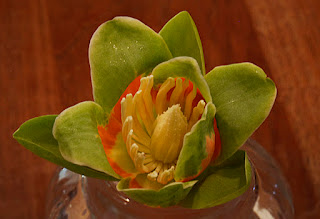Tulips Way Above the Ground
by Ferida Wolff
We have a Tulip Tree in our backyard. I remember being excited when we got it as a young seedling because we were told it would grow fast. At that time our backyard was just starting to fill out with trees, shrubs, and flowers so we were delighted with the rapid growth idea. Well, several years later and forty feet higher, the Tulip Tree is a mainstay of the yard.
And it keeps growing. We learned that it can actually grow to be 150 feet! That’s a little more than we expected.
On a recent weekend we had a visual of the potential of the Tulip Tree. We went to the opening of Duke Farms in Hillsborough, NJ, and in our walk through part of the 2,740-acre property of the Duke family we came upon some Tulip Trees that were three times the thickness of ours and way higher.
The Duke Farms is now open to the public. Its mission “is to be a model of environmental stewardship in the 21st century and to inspire visitors to become informed stewards of the land.”
Despite its size potential, I am glad we planted our Tulip Tree. It is a treat to see the tulip-like flowers each spring. It’s like having an outdoor bouquet. Most of the flowers bloom toward the top of the tree – more sun, I guess – but they eventually drop down to be admired. I learned not to press my face too close, however, as they are a source of pollen, which makes bees happy but can trigger allergic reactions.
Our tree is also a harbinger of Fall. Its leaves flutter to the ground earlier than most in a bittersweet reminder of the cycle of seasons.
American Tulip Tree:
http://www.psu.edu/dept/nkbiology/naturetrail/speciespages/poplar.htmhttp://www.untamedscience.com/biodiversity/plants/flowering-plants/dicotyledons/magnoliales/magnoliaceae/liriodendron/american-tulip-tree
©2012 Ferida Wolff for SeniorWomen.com
Editor's Note: The Wood Database comments on this tree:
Poplar, Tulip Poplar, Yellow Poplar; Scientific Name: Liriodendron tulipifera. Poplar is one of the most common utility hardwoods in the United States. Seldom used for its appearance, (except in the case of Rainbow Poplar), Poplar is a utility wood in nearly every sense. It’s used for pallets, crates, upholstered furniture frames, pulpwood, and plywood. Poplar veneer is also used for a variety of applications: either dyed in various colors, or on hidden undersides of veneered panels to counteract the pull of the glue on an exposed side that has been veneered with another, more decorative wood species.
Though the wood is commonly referred to simply as “Poplar,” it is technically not in the Populus genus itself, (the genus also includes many species of Cottonwood and Aspen), but is instead in the Liriodendron genus, which is Latin for “lily tree.”The flowers of this tree look similar to tulips, hence the common alternate name: Tulip Poplar.
More Articles
- Ferida Wolff's Backyard: Spring is Coming
- Ferida Wolff Writes: Our Senses
- The Stettheimer Doll's House: For 19 Years, Carrie Stettheimer Worked on This Three-dimensional Work of Art
- The Autobiography of a Garden at The Huntington, a Joy for Viewers and Gardeners
- Making Marvels: Science and Splendor at the Courts of Europe; Don't Miss The Draughtsman-Writer
- Ferida Wolff's Backyard: Caring for Our Climate and Our Earth; Inside and Outside; NASA's New Spacesuit for Artemis Generation Astronauts
- Swedish Design, Color and Comfort: Furniture, Glass, Textiles and Ceramics by Swedish Designers From the Late 1920s to the Early 1960s
- Ferida Wolff's Backyard: Swans and Duck Together; Life Ripens and Robin's Beautiful Eggs
- Ferida Wolff's Backyard: Nature's Progression and A Robin's Beautiful Eggs
- Truth and Beauty: The Pre-Raphaelites and the Old Masters, “Rejecting Nothing, Selecting Nothing, and Scorning Nothing"






